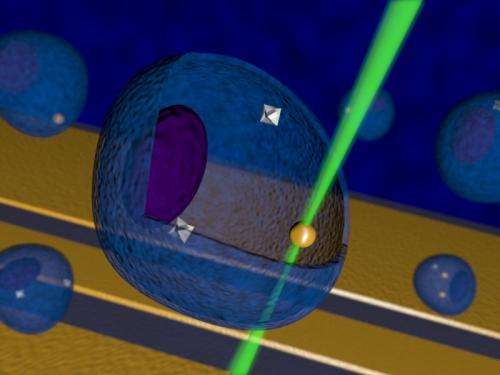August 1, 2013 report
Researchers develop nanodiamond thermometer to take temperature of individual cells

(Phys.org) —Researchers working at a lab at Harvard University have developed a technique that allows for taking the temperature of individual living cells. In their paper published in the journal Nature, the team describes their technique and just how precise temperature measurements taken with it can be.
The new thermometer developed by the team follows work by other researchers who have found that single atom impurities in diamond crystals (which typically are replaced with a nitrogen atom and a vacancy gap) can be ultrasensitive to changes in temperature—such fluctuations can be seen as a hindrance when attempting to use such material to hold quantum bits, but in the biological world, they can be used to very precisely measure temperature.
In their research the team at Harvard injected a single nanodiamond (a diamond just 100 nm in size) into a human cell. Once in place a green laser was shone onto the nanodiamond. Because it altered the spin state of an electron in the impurity, the light that was emitted was changed to red. The degree to which it was changed was then used to calculate the temperature of the interior of the cell. Following that experiment, the team injected two nanodiamonds into a single cell, then focused two separate green lasers onto them, then measured the red light that was emitted. This allowed them to measure the temperature difference between two locations in the same cell. Next, the team injected a nanodiamond and a gold particle into the cell. Once in place a green laser was shone onto the nanodiamond while another laser was shined onto the gold particle causing it to heat up. That heat was transferred to the rest of the cell and was subsequently measured by the nanodiamond.
Using this technique the researchers report being able to measure temperature fluctuations as small as 0.05 Kelvin—they expect to achieve better results in the future as temperature fluctuations as small as 0.0018 Kelvin have been recorded using the device outside of a cell. A thermometer with such precision could conceivably be used for both research purposes and in practical applications such as helping to distinguish (or kill) individual cancer cells inside the body.
More information: Nanometre-scale thermometry in a living cell, Nature 500, 54–58 (01 August 2013) doi:10.1038/nature12373
Abstract
Sensitive probing of temperature variations on nanometre scales is an outstanding challenge in many areas of modern science and technology. In particular, a thermometer capable of subdegree temperature resolution over a large range of temperatures as well as integration within a living system could provide a powerful new tool in many areas of biological, physical and chemical research. Possibilities range from the temperature-induced control of gene expression and tumour metabolism6 to the cell-selective treatment of disease7, 8 and the study of heat dissipation in integrated circuits1. By combining local light-induced heat sources with sensitive nanoscale thermometry, it may also be possible to engineer biological processes at the subcellular level. Here we demonstrate a new approach to nanoscale thermometry that uses coherent manipulation of the electronic spin associated with nitrogen–vacancy colour centres in diamond. Our technique makes it possible to detect temperature variations as small as 1.8?mK (a sensitivity of 9?mK?Hz?1/2) in an ultrapure bulk diamond sample. Using nitrogen–vacancy centres in diamond nanocrystals (nanodiamonds), we directly measure the local thermal environment on length scales as short as 200?nanometres. Finally, by introducing both nanodiamonds and gold nanoparticles into a single human embryonic fibroblast, we demonstrate temperature-gradient control and mapping at the subcellular level, enabling unique potential applications in life sciences.
Journal information: Nature
© 2013 Phys.org


















